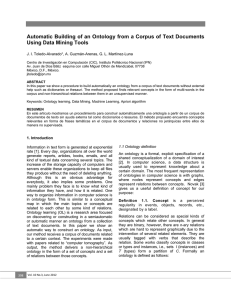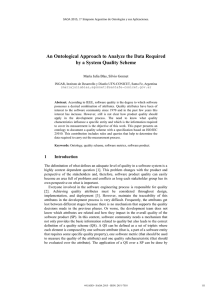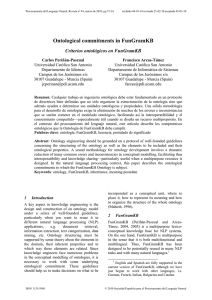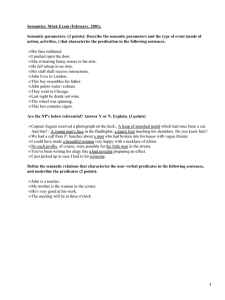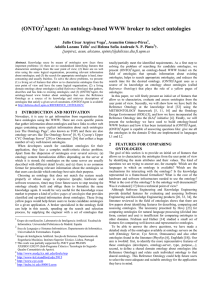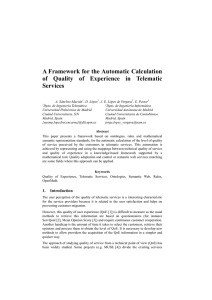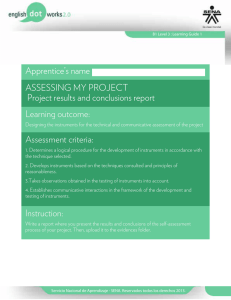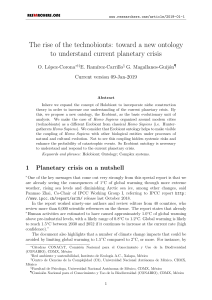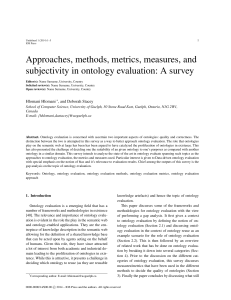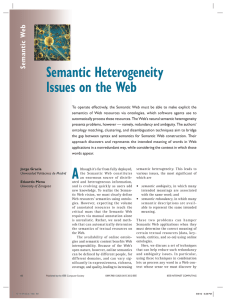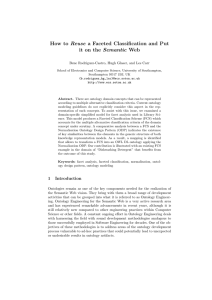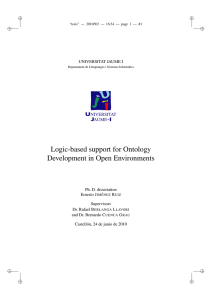EAOnto: A Heavyweight Ontology for Supporting e
Anuncio
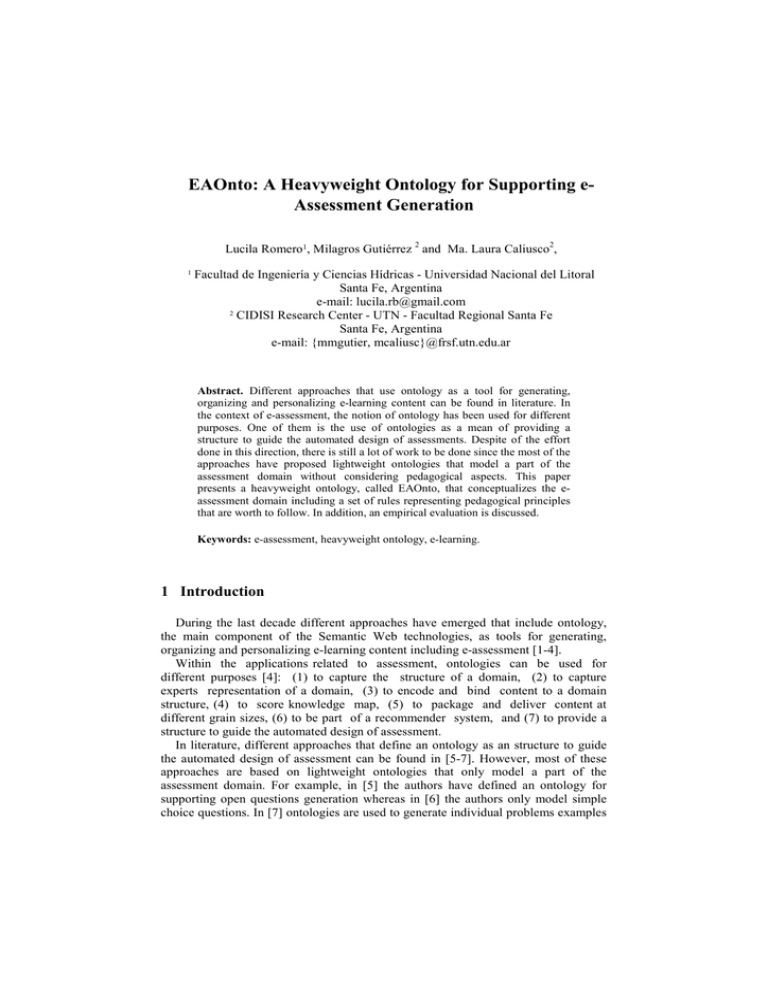
EAOnto: A Heavyweight Ontology for Supporting eAssessment Generation Lucila Romero1, Milagros Gutiérrez 2 and Ma. Laura Caliusco2, 1 Facultad de Ingeniería y Ciencias Hídricas - Universidad Nacional del Litoral Santa Fe, Argentina e-mail: [email protected] 2 CIDISI Research Center - UTN - Facultad Regional Santa Fe Santa Fe, Argentina e-mail: {mmgutier, mcaliusc}@frsf.utn.edu.ar Abstract. Different approaches that use ontology as a tool for generating, organizing and personalizing e-learning content can be found in literature. In the context of e-assessment, the notion of ontology has been used for different purposes. One of them is the use of ontologies as a mean of providing a structure to guide the automated design of assessments. Despite of the effort done in this direction, there is still a lot of work to be done since the most of the approaches have proposed lightweight ontologies that model a part of the assessment domain without considering pedagogical aspects. This paper presents a heavyweight ontology, called EAOnto, that conceptualizes the eassessment domain including a set of rules representing pedagogical principles that are worth to follow. In addition, an empirical evaluation is discussed. Keywords: e-assessment, heavyweight ontology, e-learning. 1 Introduction During the last decade different approaches have emerged that include ontology, the main component of the Semantic Web technologies, as tools for generating, organizing and personalizing e-learning content including e-assessment [1-4]. Within the applications related to assessment, ontologies can be used for different purposes [4]: (1) to capture the structure of a domain, (2) to capture experts representation of a domain, (3) to encode and bind content to a domain structure, (4) to score knowledge map, (5) to package and deliver content at different grain sizes, (6) to be part of a recommender system, and (7) to provide a structure to guide the automated design of assessment. In literature, different approaches that define an ontology as an structure to guide the automated design of assessment can be found in [5-7]. However, most of these approaches are based on lightweight ontologies that only model a part of the assessment domain. For example, in [5] the authors have defined an ontology for supporting open questions generation whereas in [6] the authors only model simple choice questions. In [7] ontologies are used to generate individual problems examples for students that consist of a question and its solution. An ontology that considers different kind of assessment was presented in [8]. However, the authors have modeled the knowledge by defining a lightweight ontology that includes concepts and a set of relationships between them. In contrast to a lightweight ontology, a heavyweight ontology is an axiomatized one that allows not only obtaining a richer semantic model but also inferring new knowledge from it [9]. In order to e-Assessment be accepted by educators, a tool for supporting to devise or create valid and reliable assessments, from a pedagogical perspective, is needed. That means, it is required to define a mechanism for to validate whether the assessment covers all the learning objectives of a course and satisfies certain pedagogical principles such as those proposed by Bolivar [10]. For this purpose, a heavyweight ontology is required. Then, the main contribution of this paper is a heavyweight ontology, called EAOnto, that formalizes the conceptualization of the knowledge related to assessments in e-learning environments. The EAOnto can be used to support the definition of an assessment with the aim of obtaining a correct assessment from structural and pedagogical perspectives. This work is organized as follows. In the next section, the main concepts related to this paper are defined. Following, the development of the EAOnto ontology is presented. Next, an empirical validation of the EAOnto using a case study is shown. Finally, conclusions and future research directions are discussed. 2 Foundation 2.1 Ontology Definition The “ontology” concept, as the literature describes it, seems to enjoy as many definitions as there are attempts to define it. In the course of this paper, we will favour the one we believe to best match the context under consideration that is based on [11]. Definition 1. An ontology is a 6-tuple consisting of concepts, relations, hierarchy, a function that relates concepts non-taxonomically, a set of axioms, and a set of rules. Formally: O: = {C, R, H, rel, A, Ru} where: Two disjoint sets, C (concepts that represents classes of objects) and R (relations that describe binary relations among concepts). A concept hierarchy, a directed relation H ⊆ C x C which is called concept hierarchy or taxonomy. So, H(C1, C2) means C1 is a subconcept of C2. A function rel: R → C x C that relates the concepts non taxonomically. A set of axioms A that are logical sentences always true that express the properties of model paradigm, expressed in an appropriate logical language. A set of logical sentences about the domain of discourse Ru (rules) expressed in an appropriate logical language. The ontology community develops two criteria to categorize the ontologies: the depth of the domain model and the amount of the restrictions on domain semantics. Based on these criteria, ontologies can be lightweight or heavyweight [9]. The former describes concepts and relationships that hold among them. The latter add axioms and rules to the first ones. Then, every heavyweight ontology has a lightweight version. The main component of a heavyweight ontology is the set of rules. Considering that the OWL language is the standard for implementing an ontology and this is not always enough to do some deduction, then it is needed to combine OWL with other representation formalism as rules. One of the integration approaches is the Semantic Web Rule Language (SWRL), which provides the ability to express Horn-like rules in terms of OWL concepts. In addition, with the aim of extracting information from OWL ontologies a query language is needed. The most powerful language is SQWRL, which is based on the SWRL rule language and uses SWRL’s strong semantic foundation as its formal underpinning [13]. 2.2 The Assessment Domain Considering didactics, assessment is necessary to evaluate the learning process and, thus, also of relevance for the e-learning situation. Several tools have emerged to collaborate with assessment process in distance situation [14-15]. However, to design a quality assessment can be considered as a difficult task when the professor has not a pedagogical ground. Assessment can be classified in formal, informal and semi-formal assessment, depending on the formality and structure of assessment instruments used [16]. Thereby the formal assessments are structured: there is a place and a time setting where they are carried out. These are different types of formal assessment: simple choice, multiple choice, correspondence, conceptual maps and performance evaluation among others. The semi-formal assessments are homework and tasks that the student makes during lesson day and continue out of it. These types of assessments are for example reading comprehension, mathematical problems, trials, projects development, programming, conclusion development, outcome analysis among other. The informal assessments are not structured at all. They consist of quizzes and activities observations that professor makes during class and consume a few minutes. Some instruments that are used to systematize these types of assessments are: class daily, control list, anecdotic annotations among other. An assessment is considered as composed of reactive. When professor develops a reactive in order to create an assessment, he uses the Bloom taxonomy [17]. It is used to classify the course or programs goals as function of six level of complexity: Knowledge: in this level professor wants to evaluate the concept memorized by students, for example question about concepts. Comprehension: professor wants to evaluate whether the student understood the semantic relation of information taught. For example, conceptual maps. Application: professor wants to evaluate whether the student can use the information taught to solve practical problems, ie. mathematic problem Analysis: professor wants to evaluate the structure of knowledge. Synthesis: professor wants to evaluate whether the student can develop original approaches based on the concepts taught. Evaluation: professor wants to evaluate whether the student can make a value judgment on topics taught. 3. The EAOnto Development In order to develop the EAOnto ontology, the METHONTOLOGY Methodology was followed [18] and the ontology was implemented by using the Protégé Editor (http://protege.stanford.edu). Following, the description of the EAOnto is presented. 3.1 The EAOnto Ontology The main concept of the EAOnto is the Assessment. Assessments are part of the educational resources involved in the Teaching-Learning (TL) process when a professor wants to evaluate the concepts learned by students. An assessment is composed by activities, where activity is a motto or exercise that evaluates a particular domain topic. Each activity is composed by one or more reactives. A reactive is an item that uses an assessment instrument. The EAOnto ontology models different instruments that could be used in an assessment depending on the evaluation technique implemented by using the term Instrument. An assessment instrument is the physical support that it is used to collect the information about the expected learning of students. In the ontology are differentiated Formal instruments and Semiformal instruments as part of the use of formal techniques and semiformal techniques respectively. As Formal instruments of assessment, we consider instruments as part of techniques that demand a process of more sophisticated planning and are used regularly to complete a full cycle of TL process. As one of the main concepts of the ontology we define Objective Activity. In this type of activity, the student need not construct or write a response but read the question, think about the answer, identify or mark and complete it. This activity needs brief answers. With this type of activity the subjectivity in the rating is eliminated. There are different types of Objective Activities as seen in Figure 1: Choice: MultipleChoice or SimpleChoice items consist of a statement that may be a phrase or question followed by four or more answer choices, represented in the ontology by the concept Option. The concept ObjectiveActivity is related with the concept Option with the relation hasOption. The concept Option is specialized in two sub-concepts: Distractor and TrueOption. Distractor are items that are not correct and TrueOption is the correct item: SimpleChoice: Contains only one correct option. MultipleChoice: Can have more than one correct option. In both last cases (Multiple and Simple choice), it is recommended that there is always a right option. It is recommended also that this type of activities do not include options such as "none of the above" or "all of them". These restrictions, among others, are implemented as rules in the ontology. In general, items should belong to the context of content area being assessed in a clear and simple way and preferably written in the affirmative mode. Distractors should appear as attractive as possible to the uninformed student. Completion: In completion type activities, the student must write the answer in a blank space provided for this purpose. This type of activity presents difficulties of writing, such as the complexity of drafting an incomplete statement, so that there is only one correct answer. Correspondence: This concept describes the activities in which there are two types of lists or columns of names, facts or principles. In one column the professor writes the list of premises. In another column are written alternatives of answer. Correspondence activities are very useful in the evaluation of academic performance and that through them can present a large amount of content. Some recommendations are: contain clear instructions to perform the mapping, include relevant material on each item; do not include more than six premises in the first column, among others. IsComposed By use Reactive Instrument Assessment Formal Instrument Activity Objective Activity IsComposedBy Correspondence Completion Choice hasOption Simple choice Option TrueOption hasAnswer Answer hasBoolean Answer Distractor Multiple choice TrueFalse Relation Numeric Text Fig 1. Assessment Instrument Ontology. Formal instruments: Objective Activities. Completion and correspondence activities are related with the concept Answer (has Answer relation). This concept symbolizes the fact that there are different types of responses that these types of activities may have: TrueFalse, Numeric, Text, Relation. Figure 2 shows other types of formal instruments that can be used in activities also considered in the ontology: Essay Activity: This concept defines assessments of complex learning where professor wants to check the ability of students to produce, organize and express their ideas in writing and his independent reasoning ability. This concept is specialized in two sub-concepts: o Restricted essay: Professor asks the student a short and precise answer: “Enumerate…”, “Define..”, “Describe…”, among others. o Unrestricted essay: Professor gives the student freedom as to the nature and extent of their response (with time limit or number of pages). As semi formal instruments, first we considered atomic instruments such as exercises, conceptual maps or essays, and secondly portfolios. The later consist of a collection of atomic elements that help professor record learning process and student’s progress, such as conceptual maps, essays or exercises. Conceptual Map defines activities that correspond to resources that can represent hierarchical graphics, concepts and propositions about a given topic. It can be made in three variants: (1) from a central theme or concept, (2) from a group or list of concepts proposed by professor, and (3) from a conceptual map or structure already developed to incorporate new concepts. These instruments are also considered in the ontology and can be observed in the same figure. Fig. 2. Assessment Instrument Ontology. Formal and semiformal instruments. 3.2 Rules for determining the assessment quality There are same pedagogical rules that professor need to take into account in the development of assessment [10][19]. If these rules are followed we can say that the assessment is valid in a pedagogical sense. In this work we have used some proposed rules in order to define SWRL sentences to express the restriction in the generation of valid assessment. Table I shows the pedagogical rules that have been taken into account. The first column describes the rule in a colloquial language. Second column shows the fist-order logic description of such rules. Note that in using First-order logic we consider reification of concepts such as: Option ∈ Options Simple choice ∈ simpleChoices trueOption ∈ TrueOptions Multiple choice ∈ multipleChoices attribute ∈ attributes Table 1. Pedagogical rules for simple and multiple choice in first-order logic. Description First-Order Logic 1. a simple choice activity must have at least four options Simple choice ℑ|= ∀x ∈ simpleChoices (∃ y, z, w, r ∈ Options (hasOption(x,y)∧hasOption(x,z) ∧hasOption(x,w) ∧hasOption(x,r) ∧y≠z≠w≠r ∧z≠w≠r ∧w≠r) 2. A simple choice activity must have only one true option ℑ|= ∀ x∈simpleChoices (∃!y ∈ TrueOptions hasOption(x,y)) 3. A multiple choice activity must have more than one true option. Multiple choice ℑ|= ∀ x∈multipleChoices (∃ y, z ∈ TrueOptions hasOption(x,y) ∧hasOption(x,z) ∧y≠z) 4. A multiple choice activity must have more than four options. ℑ|=∀x ∈ multipleChoices (∃ y, z, w, r ∈ Options (hasOption(x,y)∧hasOption(x,z) ∧hasOption(x,w) ∧hasOption(x,r) ∧y≠z≠w≠r ∧z≠w≠r ∧w≠r) 5. A multiple choice activity cannot have option like: “all of them” or “none of them” ℑ|= ∀x∈multipleChoices (∃ y ∈ Options ((hasOption(x,y) ∧ ∃ z ∈ attributes (hasAttribute(y, z) ∧ value(z,w) ∧ (w ≠ “all of them” ∨ w≠ “none of them”))) Then, we can say that an assessment is valid if it is compliant with the above rules. In order to check the validity of an assessment generated with the proposed ontology we have implemented these rules using SWRL and SQWRL languages. Beginning with simple choices, rules 1 and 2 were implemented: SimpleChoice(?sc)∧Option(?o) ∧ hasOption(?sc,?o)∧ sqwrl:makeSet(?os,?o)∧sqwrl:groupBy(?os,?sc)∧ (1) sqwrl:size(?t,?os)∧sqwrl:greaterThanOrEqual(?t,4)⇒ optionQuantityValid(?sc) SimpleChoice(?sc)∧distractor(?d)∧sqwrl:makeSet(?s1, ?d)∧ (2) sqwrl:groupBy(?s1,?sc)∧ sqwrl:size(?t,?s1)∧sqwrl:equal(?t,1)⇒ answerQuantityValid(?sc) As regards multiple choices we have three restrictions 3, 4 and 5 in table I that are represented with sentences (3), (4) (5) and (6) respectively. Note that the restriction 5 was represented with two sentences 5 and 6 for simplicity. MultipleChoice(?mc) ∧ distractor(?d) ∧ sqwrl:makeSet(?s1, ?d) ∧ sqwrl:groupBy(?s1, ?mc) ∧ sqwrl:size(?t, ?s1) ∧ sqwrl:greaterThan(?t,1) ∧ answerQuantityValid(?mc) MultipleChoice(?mc) ∧ Option(?o) ∧ hasOption(?mc, ?o) ∧ sqwrl:makeSet(?os, ?o) ∧ sqwrl:groupBy(?os, ?mc) ∧ sqwrl:size(?t, ?os) ∧ sqwrl:greaterThan(?t,4) ⇒ optionQuantityValid(?mc) MultipleChoice(?mc) ∧ hasOption(?mc, ?o) ∧ label(?o, ?l) ∧ (3) (4) (5) sqwrl:normalizeSpace(?n,?l) ∧ sqwrl:stringEqualIgnoreCase(?n, “all of them”) ⇒ whithoutAll(?mc) multipleChoice(?mc) ∧ hasOption(?mc, ?o) ∧ lavel(?o, ?l) ∧ sqwrl:normalizeSpace(?n,?l) ∧ sqwrl:stringEqualIgnoreCase(?n, “none of them”) ⇒ withoutNon(?mc) (6) Finally, if a simple choice meets the restriction (1) and (2) we can say that this simple choice is valid. This statement is represented with the following rule: SimpleChoice(?sc) ∧optionQuantityValid(?sc) ∧ answerQuantityValid(?sc) ⇒ validSimpleChoice(?sc) (7) In the same way, if a multiple choices meets the restriction (3), (4), (5) and (6) is a valid multiple choices: multipleChoice(?mc) ∧whithoutAll(?mc) ∧whithoutNon(?mc) ∧optionQuantityValid(?mc) ∧answerQuantityValid(?mc) ⇒ validMultipleChoice(?mc) 4 (8) EXPERIMENTS AND DISCUSSIONS In order to empirically evaluate the EAOnto, a case study based on a final exam related to an Artificial Intelligence course was considered. The assessment is composed by three activities as shown in Figure 3. The first activity is about search domain topic and has two reactives both of them use completions instruments. The second is about Machine learning domain topic and has one reactive corresponding to a multiple choices instrument. The latter is about Perspective projection and has one reactive corresponding to a simple choice. Fig. 3. The Artificial intelligence assessment (from http://www.ai-class.com/). Figure 4 shows the AI assessment represented by ExamIntroductionToAI_2011 instance. It has three activities: SearchActivity, MachingLearningActivity and PerspectiveProjectionActivity. Instance-of Instance-of ExamIntroduction ToAI SearchActivity IsComposedBy Instance-of Instance-of MachingLearning Activity PerspectiveProjection Activity IsComposedBy IsComposedBy Fig. 4. The Artificial intelligence assessment instance. Each activity has a set of reactives, which in term use some instruments. Figure 5 shows the instances associated with searchActivity. It has two reactives item1 and item2 both of them use instances of completion as instruments. Fig. 5. Search Activity from AI Assessment as instances of EAOnto. Once inserted the instances, the ontology was able to make infereces, as for example to infer the assessment consistence or even the validity of the assessment from a pedagogical perspective. The first inference can be done by using a general reasoner following the axioms associated to the language in which the ontology is represented. In the case study, the Pellet reasoner was used. In order to make the second inference, the rules defined in the previous section were implemented by using the SWRL Rules Tab of the Protégé Editor. In the case study, the execution of the rules inferred that the third activity is not a valid simple choice from a pedagogical point of view, because it contains three options (Rule 4). 5 CONCLUSIONS AND FUTURE WORK This work has shown an ontology, called EAOnto, which purpose is to conceptualize the assessment domain in a TL process with the aim of supporting the generation of assessments in an e-learning context. In contrast to previous work, EAOnto is a heavyweight ontology that models the different kinds of assessments. The main component of the EAOnto ontology is the rules defined in SWRL and SQWRL. These rules determine the validity of a given assessment based on pedagogical criteria. This is a useful tool at the moment of defining an assessment to ensure its quality from a pedagogical perspective. In order to illustrate the use of the EAOnto, an example for an Artificial Intelligence assessment was discussed. In the future, we intend to acquire additional validation assessments for a broad evaluation and refinement of the ontology. References 1. Knight, C., Gašević, D., & Richards, G.: An ontology-based framework for bridging learning design and learning content." educational technology & society, 9 (1) 23-37 (2006) 2. Romero, L.; Godoy J.: An ontology for semantic definition of learning objects. Proc. 5th Conferencia Ibérica de Sistemas y Tecnologías de Información, Santiago de Compostela, 420-426 (2006) 3. Panteleyev, M., Puzankov, D., Sazykin, P., & Sergeyev, D.: Intelligent educational environments based on the semantic web technologies. Proc. Of the ieee international conference on artificial intelligence systems, russia, 457-462 (2002) 4. Mcmullen, D.: Using ontology technology to support content generation and run time adaptivity in e-learning environments. M.Sc. Dissertation, School of Computing, Dublin City University (2007) 5. Cubric, M. and Tosic, M.: Towards automatic generation of e-assessment using semantic web technologies. Proc. International Computer Assisted Assessment Conference (2010) 6. Castellanos-Nieves, D., Fernandez-Breis, J., Valencia-Garcia, R., Martinez-Bjar, R., Iniesta-Moreno, M.: Semantic web technologies for supporting learning assessment. Information Sciences, 3rd ed., vol. 2., 68–73 (2011) 7. Holohan, E., Melia, M., Mcmullen, D., Pahl, C.: The generation of e-learning excercises problems from subject ontologies. Proc. 6th International Conference on Advanced Learning Technologies (2006) 8. Romero, L., Leone, H. Una ontología para el dominio de evaluación del aprendizaje. Martín llamas nistal, carlos vaz de carvalho, y carlos rueda artunduaga, editores. Ticai2007: tics para el aprendizaje de la ingeniería. Isbn 978-84-8158-380-9 17-24, ©IEEE (2007) 9. Gómez-Pérez, A., Fernandez López M. and Corcho, O.: Ontological engineering with examples from the areas of knowledge management, ecommerce and the semantic web, , London: Springer (2004) 10. C. Bolivar.: Pruebas de rendimiento académico. Technical Report. Programa interinstitucional doctorado en educación (2011) 11. Maedche, A. Ontology Learning for the Sematic Web. Kluwer Academic Publishers (2002) 12. Allocca, C., D'aquin, M., and Motta, E.: DOOR-Towards a formalization of ontology relations. In Dietz, J.L.G. Ed, International Conference on knowledge engineering and ontology development,13-20. Insticc Press (2009) 13. O’connor, M. and Das, A.: SQWRL: a query language for owl. In Proc. of 6th workshop OWL: Experiences and Directions (2009) 14. Vitturini, M.; Benedetti, L.; Señas, P.: Una nueva herramienta de evaluación basada en Filtros de Corrección Automática (FCA). TE&ET | Revista Iberoamericana de Tecnología en Educación y Educación en Tecnología. Nro 6, 43-51, (2011) 15. Romero, L. Vera, M., Leone, H.: Sistema Web Tutorial como soporte para la enseñanza de Paradigmas de Programación en la carrera Ingeniería en Sistemas de Información. In Proc. I Congreso de tecnología en educación y educación en tecnología. TE&ET. (2006) 16. Berliner, D: In pursuit of the expert pedagogue. Educational research 15(7), 5-13 (1986) 17. Bloom, B.; Krathwohl, D.: Taxonomy of educational objectives. The classification of educational goals by a committee of college and university examiners. Handbook 1. Cognitive domain. New york: Addison-Wesley (1956) 18. Corcho, O., M. Fernandez-Lopez, A. Gorez and A. Lopez-Cima: Building legal ontologies with METHONTOLOGY and WEBODE2, in law and the semantic web. Legal ontologies, methodologies, legal information retrieval, and applications (2005) 19. Diaz, F. and Barriga, A.: Capítulo 8: Estrategias docentes para un aprendizaje significativo: una interpretación constructivista. México: McGraw Hill. (2008)
